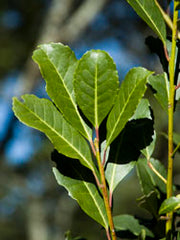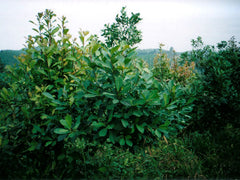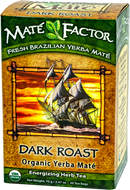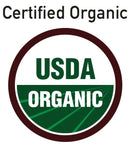Description
Read about the qualities of Yerba Mate, the amazing herb from South America.
The yerba mate tree is an evergreen from the Holly family that grows in the subtropical forests of South America. The yerba mate tree, from the Aquifoliacae family, stands between 6 to 8 meters tall, being able to even reach 15 meters. There are many different species in the family, the Ilex genus having more than 550, the holly plant included, 280 species found in South America, 60 of which occur in southern Brazil. Only 3 species though are used in the mate industry (I. paraguariensis, I. angustifolia, I. amara), Ilex Paraguariensis being the most important. The mate plant, due to the widespread genetic variety of the Ilex family, may have white or light purple stems, and thick waxy leaves that may present dented or smooth edges

The Flavor
The amount of xanthene alkaloids in the leaves of mat is believed to be directly related to the quality of the soil. This influences the flavor of the yerba mate giving it a milder taste. This flavor varies from region to region, the soil of southern Brazil presenting drastic variations in mineral content, texture, and organic mass. The tendency though, is for the cultivated mat to have a stronger bitterness, and probably higher xanthene content. The native trees, which grow in the nitrogen-rich topsoil of the Paran Pine forests, tend to have a milder bitterness, characterized by a stronger leafy flavor. Obtaining the right balance of these is the secret to having a stable, fresh tasting yerba mate.
Size and Shape of the Trees and Leaves
The factor that characterizes the size and shape of the yerba mate trees is the amount of sunlight received. In the dense subtropical forest, the fight for sunlight has developed the trees so that they have long slender trunks with a large leafy top. This applies to the native yerba mate trees, which develop a longer trunk, reaching 45 feet tall to reach the sunlight. The cultivated trees are pruned to spread, creating large bushes, which rarely develop large trunks. They are carefully harvested each season to maintain the bush-like shape which eases the labor in harvesting. The leaves also present a difference in size and shape. The native leaves are usually smaller and darker in color. The cultivated leaves are larger, and occasionally, the serrated edge of the leaf becomes less evident.
Growing Mate Organically

One of the obstacles faced by cultivated yerba mate is the weeds. The use of herbicides is widespread in cultivated areas, therefore posing threats to the natural balance of the subtropical forests and grasslands. For this reason, we have also chosen yerba mate plantations that are surrounded by native forest. This avoids all possibility of contamination. The International Organic Regulations are followed in all of our certified plantations. Native yerba mate doesnt face the same challenge, as the weeds do not grow in the dense forest. Most native yerba mate is, by default, organic. We have all our native yerba mate areas certified though, and conduct extraction in a manner that doesnt damage the other vegetation in the forest.

Copyright 2010 The Mate Factor - The information and pictures on this page may not be reproduced for commercial purposes without permission from Mate Factor.
Note: This description fits the yerba mate grown and processed by The Mate Factor. Yerba Mate processed or cultivating by other companies may not fit the same description.
Botanical Name: Ilex Paraguariensis (Part of the Holly Family)
Minerals Richly Found in Yerba Maté that Support Metabolism and Development.
- chromium
- copper
- iron
- manganese
- potassium
- zinc
|
Compound |
Biological activities |
|
Caffeine |
Anticarcinogenic, antiobesity, antioxidant, antitumor, diuretic, energizer 20 to 200 mg, stimulant, topoisomerase-I-inhibitor 0.1 M, topoisomerase-II-inhibitor 99 mM, vasodilator |
|
Chlorogenic-acid |
Antioxidant IC50= 54.2 μM, analgesic, antiatherosclerotic, antibacterial, antidiabetic, antitumor, choleretic |
|
Chlorophyll |
Antibacterial, anticancer |
|
Choline |
Antidiabetic, cholinergic, lipotropic |
|
Nicotinic acid |
Choleretic, hypocholesterolemic 1 to 6 g/day |
|
Pantothenic acid |
Antiallergic 100 to 500 mg/day, antiarthritic 500 to 2000 mg/day, antifatigue |
|
Rutin |
50= 30 ppm IC 50= 120 μM, antitumor, antitumor-promoter, antiulcer, cAMP-phosphodiesterase-inhibitor, topoisomerase-II-inhibitor IC50= 1 μg/mL, vasodilator |
|
Tannin |
Antioxidant 1/3 quercetin IC50= 1.44 μg/mL, antitumor, antitumor-promoter, lipoxygenase-inhibitor, MAO-inhibitore |
|
Theobromine |
cAMP-inhibitor IC50= 0.06 mg/mL, cAMP-phosphodiesterase-inhibitor, diuretic 300 to 600 mg/day, stimulant, myorelaxant |
|
Theophylline |
cAMP-inhibitor IC50= 0.06 mg/mL, cAMP-phosphodiesterase-inhibitor, diuretic, choleretic, stimulant, vasodilator, myorelaxant 100 μM |
|
Ursolic acid |
Analgesic, antioxidant IC50= 10 μM, antiperoxidant IC35= 200 μg/mL, protease-inhibitor IC85= 18 μg/mL, topoisomerase-II-inhibitor, antiarrhythmic, anticancer, antialzheimer |
More Antioxidants than Green Tea - Antioxidants in Yerba Mate
Studies show Yerba Mate to be higher in antioxidants than Green Tea. Partially responsible for this is the high levels of polyphenols found in Yerba Mate. Polyphenols are indicated to perform similarly to the 293 natural antioxidant enzymes in the body, and are believed to support these natural health promoting systems.
Largely responsible for the high antioxidant value of Yerba Mate are the very high levels of caffeoyl derivatives found in Mate compared to other plants. These include caffeic acid, chlorogenic acid, 3, 4-dicaffeoylquinic acid, 3, 5-dicaffeoylquinic acid, and 4, 5-dicaffeoylquinic acid.
Polyphenols in Yerba Mate:
- Caffeic Acid
- Caffeine
- Caffeoyl Derivatives
- Caffeoylshikimic Acid
- Chlorogenic Acid
- Feruloylquinic Acid
- Kaempferol
- Quercetin
- Quinic Acid
- Rutin
- Theobromine
The Healthy Energizer
The energizing effects of Yerba Mate are longer lasting than traditional caffeine beverages, and are found by most to be free from side effects such as, the jitters, mood swings, addiction, and post stimulation fatigue. The bottom line is, Yerba Mate gives you energy that really feels good.
Yerba Mate has 3 xanthine alkaloids, working together with a rich host of nutritional components, creating the unique healthy energizing effect. The xanthines are caffeine, theobromine and Theophylline. Mate is low in caffeine, and theophylline, yet high in theobromine, which has less effect on your nervous system than caffeine. A hypothesis exists that Yerba Mate contains its own unique xanthine alkaloid that hasn't been clinically identified yet.
Anecdotally, the overwhelming majority have reported that Yerba Mate does not give them the health problems they experience from coffee. Many who have had problems with caffeine and desire to get off of it, find Yerba Mate to be the answer they were looking for.
Yerba Mate & Weight Loss
Yerba Mate is believed to aid in weight loss and has growing interest in those studying obesity control. Studies cite Yerba Mate to potentially interfere with cholesterol metabolism and delay intestinal absorption of dietary fat.
Obese men and women consuming Mate tea have shown a decrease in respiratory quotient (RQ), indicating an increase in fat oxidation.
A study done in 1998 at the Foundation University of Rio Grande, Brazil, showed that Mate is capable of vaso relaxation of arterial beds, which indicates that it may be able to lower the risk for heart disease in the same way that red wine is believed to do.
The thermogenic effect of Yerba Mate has been the source of interest to both researchers and those desiring to lose weight.
References:
1C.I. Heck and E.G. de Mejia; Yerba Mate Tea (Ilex paraguariensis): A Comprehensive Review on Chemistry, Health Implications, and Technological Considerations., J. Food Science 17-Oct-2007; DOI 10.1111/j.1750-3841.2007.00535.x.
2Filip R, Lotito SB, Ferraro G, Fraga CG. 2000. Antioxidant activity of Ilex paraguariensis and related species. Nutr Res 20:1437–46.
3Bixby M, Spieler L, Menini T, Gugliucci A. 2005. Ilex paraguariensis extracts are potent inhibitors of nitrosative stress: a comparative study with green tea and wines using a protein nitration model and mammalian cell cytotoxicity. Life Sci 77:345–5.
4Muccillo Baisch AL, Johnston KB, Paganini Stein FL. 1998. Endothelium-dependent vasorelaxing activity of aqueous extracts of Ilex paraguariensis on mesenteric arterial bed of rats. J Ethnopharmacol 60:133–9.
5Martinet A, Hostettmann K, Schutz Y. 1999. Thermogenic effects of commercially available plant preparations aimed at treating human obesity. Phytomedicine 6:231–8.
6Dickel ML, Rates SM, Ritter MR. 2007. Plants popularly used for losing weight purposes in Porto Alegre, South Brazil. J Ethnopharmacol 109:60–71.
7Carini M, Facino RM, Aldini G, Calloni M, Colombo L. 1998. Characterization of phenolic antioxidants from Mate (Ilex paraguayensis) by liquid chromatography mass spectrometry and liquid chromatography tandem mass spectrometry. Rapid Commun in Mass Spec 12:1813–9.
Payment & Security
Your payment information is processed securely. We do not store credit card details nor have access to your credit card information.




